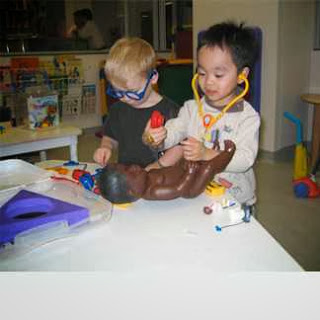What is play therapy?
I am a Registered Play Therapist
supervisor and I often get the question, “So you just play with kids?” or “Do
you just watch them play?” After 7 years of educational training specializing
in play therapy, I do not just watch a child play, here is what I do from a
theoretical perspective.
What is play therapy?
The purpose of play therapy is to
allow the child the conditions and the relationship to release their inner
world in an expressive way that is appropriate for their cognitive and
emotional development. Virginia Axline,
a student of Carl Rogers, applied the client-centered approach to working with
children and developed child-centered play therapy. Axline (1947/1969) stated,
“Play therapy is based upon the fact that play is the child’s natural medium of
self-expression” (p. 9). From a child- centered play therapists’ perspective,
play is the therapeutic process. Self- directed play and the relationship are
the vehicles of change, toys are the children’s words and play is their
language (Landreth, 2002). The purpose of play and process of change occurs
within the child, Landreth (1993) stated, “The relationship that develops and
the creative forces this relationship releases in the child generate the
process of change and growth for the child” (p. 20). Therefore the child
through play in a safe environment awakens his or her inner ability to self-
direct and self- evaluate (Moustakas, 1997). The purpose of play is for the
child to rediscover their inner wisdom and use their inner voice to deal with
the unpredictable world around them.
How is structure created in the play room and will my
child benefit from you sitting there?
In child- centered play
therapy, the child leads and the therapist follows. The structure is to provide
safety, freedom, and self- control through limit setting, self-directed play,
and returning responsibility (Landreth, 2002). According to Axline (1955) the
purpose of structure is, “If the child experiences consistent, predictable
boundaries of time and place, he gains a sense of stability and security” (p.
128). According to Landreth (2002), the play therapist can structure the
relationship with the child in the play room by the choices of their words, for
example by introducing the play room and concluding the session. By the therapist
nonverbal communication, structure in the relationship is also communicated to
the child. Landreth (2002) stated, “Because this is the child’s time, the
therapist should now sit down, further communication to the child willingness
to allow the child to lead” (p. 183). The therapist also structures by
maintaining and respecting the child’s boundaries in the play room. The
therapist only physically gets near the child or interacts in the child’s play
when the child invites the therapist to interact in his/her play. Lastly, a
child- centered play therapist does not push a child to talk or play in an
attempt to fulfill the therapist’s agenda or need. Contrarily the therapist is
accepting of the child’s feelings and validates the child’s feelings despite whether
the child sits in the corner and chooses to not speak and play or not
(Landreth, 2002). Therefore structure is to provide a sense of safety and
security in the relationship with the child.
How does change
occur in play therapy?
The therapist provides warmth and
understanding through empathic reflections. Due to the therapeutic relationship
being so crucial in child- centered play therapy, the therapist’s role is
communication of; “I am here”, “I hear you”, “I understand”, and “I care about
you” (Landreth, 1993). The therapist has a non-judgmental and accepting way of
being. The child- centered therapist trusts the child’s intrinsic motivation
toward self- actualization and more importantly understands the child’s
perception of reality with respect (Landreth, 1993). The child-centered play
therapist trusts that distressing feelings will be resolved within the child
and unconsciously manifested without the therapist manipulation or education
(Moustakas, 1997). Therefore the main role of the therapist is trust that
within the child is an innate ability to affect his or her own healing through
the power of the therapeutic relationship.
References:
Axline, V. (1947). Play Therapy:
The Inner Dynamics of Childhood. Cambridge, MA: Houghton Mifflin.
Axline, V. (1955). Play therapy
procedures and results. American Journal
of Orthopsychiatry, 25, 618-626.
Landreth, G. (1993).
Child-centered play therapy. Elementary
School Guidance & Counseling, 28 (1), 17-29.
Landreth, G. (2002). Play therapy: The art of the relationship
(2nd ed.). New
York: Brunner-Routledge.
Moustakas, C. E. (1997). Relationship play therapy. Northvale,
NJ: Aronson.



Comments
Post a Comment